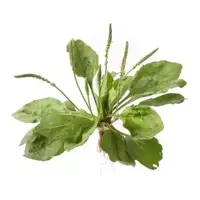Plantain

The perennial herbaceous plantain plant belongs to the Plantain family. The height of the plant on average varies between 10-40 centimeters, while the plantain is characterized by the presence of a basal rosette consisting of bare green leaves and several flower arrows.
The plantain has large leaves, which can be described as wide-ovate, long-necked, with pronounced longitudinal veins. The floral arrows of the plantain are leafless, while at the ends they form a long cylindrical ear, which consists of small brown flowers. After flowering, fruits form on the arrows - two-sided boxes.
A distinctive property of plantain can be called its unpretentiousness - this plant can live almost everywhere: near housing, near roads, in wastelands, meadows, weeds, fields and gardens, along the banks of water bodies and edges. Plantain is very widespread - it is found everywhere, with the exception of the Far North.
The use of plantain for food has a long history, so it is safe to declare that in cooking this plant is not considered a novice similar to dandelion, sorrel, sour and other plants, with which it is perfectly combined when preparing various dishes - from salads to hot meals.
In general, for culinary purposes, it is customary to use the young foliage of the big plantain. It is based on excellent salads combined with potatoes, onions, green salad, horseradish, swan, nettle, as well as casseroles, omelets, porridge, mash, cutlets and even drinks. Some hostesses prepare vinaigrettes, cabbage soup, caviar rolls, sandwiches from plantain, make soup dressing and brew tea with this plant.
Composition of plantain
The composition of plantain contains such valuable elements as flavonoids, tannins, vitamin K, citric and ascorbic acid, bitterness, glycosides, polysaccharides. In addition, traces of alkaloids, phytoncides, venine along with factor T, which can increase blood clotting, were found in the leaves of this plant.
Benefits of plantain
In official medicine, the benefits of plantain are not questioned, because drugs based on it differ in astringent, wound-healing and hemostatic properties. In addition, juice from fresh plantain leaves helps in the treatment of corneal wounds, as it contributes to the suppression of the growth of the pseudomonas bacillus and pathogenic staphylococcus.
Representatives of unconventional therapy also know about the benefits of plantain and actively use it. For example, seeds of this plant are most often used, from which a decoction is made that is effective for eye diseases, female and male infertility, as well as diabetes mellitus.
The harm of plantain
Regarding the harm of plantain, we can say that adverse consequences from its use and use are possible in the event of a stomach ulcer, in which an increased level of acidity of gastric juice is observed. In addition, it is not recommended to use plantain if a person has a tendency to form blood clots.
plantain 26 kKal
Energy value of plantain (Ratio of proteins, fats, carbohydrates - ju):
Proteins: 0.4 g (~ 2 kCal)
Fats: 0.09 g. (~ 1 kCal)
Carbohydrates: 7g (~ 28kCal)
Energy ratio (bj | y): 6% | 3% | 108%
 Español
Español Français
Français Português
Português Русский
Русский 简体中文
简体中文 繁體中文
繁體中文 日本語
日本語 한국어
한국어 العربية
العربية Türkçe
Türkçe Қазақ
Қазақ Deutsch
Deutsch Italiano
Italiano Українська
Українська
